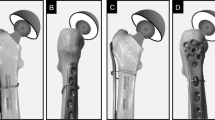Abstract
Introduction
Failure of proximal femoral fracture managed by proximal femoral nail (PFN) leads to a very difficult situation to handle with conventional techniques, and reversed distal femoral locking compression plate (DF-LCP) is of great benefit in these selective cases.
Methods
Twelve patients with ununited proximal femoral fractures including subtrochanteric fractures with a failed PFN implant were included in the study. All patients with periprosthetic fractures and fractures treated by implants other than PFN were excluded from this study.
Result
All fractures went into union in an average time of nine months and 15 days with no implant failures. The mean time of re-osteosynthesis after the primary index surgery of PFN was one year eight months. Mean surgical time of re-osteosynthesis was 110 minutes, and average blood loss during surgery was 550 ml.
Discussion
The PFM is one of the most commonly used implant for unstable proximal femur fractures. The use of PFN is technically demanding and is associated with high failure rates. Although dynamic compression screw (DCS), proximal femoral locking plate (PF-LCP) and other implants can be used in these failed situations, they are associated with a high complication rate. The reversed DF-LCP is a rescue implant for these complex situations. Apart from anatomical and biomechanical advantages, there are several other clinical benefits of using DF-LCP.
Conclusion
We conclude that DF-LCP is a potential and safe implant of choice for the management of nonunion associated with failed PFN. It may be considered an implant of choice as rescue from such a complex situation. It offers several anatomical, biomechanical and clinical advantages over other available conventional implants.







Similar content being viewed by others
References
Schipper IB, Steyerberg EW, Castelein RM et al (2004) Treatment of unstable trochanteric fractures: randomized comparison of the gamma nail and the proximal femoral nail. J Bone Joint Surg (Br) 86(1):86–94
Simpson AH, Varty K, Dodd CA (1989) Sliding hip screws: modes of failure. Injury 20:227–231
Davis TR, Sher JL, Horsman A et al (1990) Intertrochanteric femoral fractures: mechanical failure after internal fixation. J Bone Joint Surg (Br) 72(1):26–31
Boldin C, Seibert FJ, Fankhauser F et al (2003) The proximal femoral nail (PFN)—a minimal invasive treatment of unstable proximal femoral fracturesA prospective study of 55 patients with a follow-up of 15 months. Acta Orthop Scand 74(1):53–58
Simmermacher RKJ, Bosch AM, Van der Werken C (1999) The AO/ASIF-proximal femoral nail (PFN): a new device for the treatment of unstable proximal femoral fractures. Injury 30:327–332
Kanthimathi B, Narayanan VL (2012) Early complications in proximal femoral nailing done for treatment of subtrochanteric fractures. Malays Orthop J 6(1):25–9
Lee WT, Murphy D, Kagda FH et al (2014) Proximal femoral locking compression plate for proximal femoral fractures. J Orthop Surg (Hong Kong) 22:287–293
Newey ML, Ricketts D, Roberts L (1993) The AO classification of long bone fractures: an early study of its use in clinical practice. Injury 24(5):309–12
Ehlingera M, Brinkerta D, Bessea J et al (2011) Reversed anatomic distal femur locking plate for periprosthetic hip fracture fixation. Orthop Traumatol: Surg Res 97:560–564
Pape HC, Tarkin IS (2009) Intraoperative reduction techniques for difficult femoral fractures. J Orthop Trauma 23(5):S6–11
Cummings SR, Melton LJ (2002) Epidemiology and outcomes of osteoporotic fractures. Lancet 359:1761–1767
Tencer AF, Johnson KD, Johnston D et al (1984) A biomechanical comparison of various methods of stabilization of subtrochanteric fractures of the femur. J Orthop Res 2:297–305
Kang SH, Han SK, Kim YS et al (2013) Treatment of subtrochanteric nonunion of the femur: whether to leave or to exchange the previous hardware. Acta Orthop Traumatol Turc 47(2):91–95
Bredbenner TL, Snyder SA, Mazloomi FR et al (2005) Subtrochanteric fixation stability depends on discrete fracture surface points. Clin Orthop Relat Res 432:217–225
Parker MJ, Dutta BK, Sivaji C et al (1997) Subtrochanteric fractures of the femur. Injury 28:91–95
Zhou F, Zhang ZS, Yang H et al (2012) Less invasive stabilization system (LISS) versus proximal femoral nail anti-rotation (PFNA) in treating proximal femoral fractures: a prospective randomized study. J Orthop Trauma 26:155–162
Tyllianakis M, Panagopoulos A et al (2004) Treatment of extracapsular hip fractures with the proximal femoral nail (PFN): long-term results in 45 patients. Acta Orthop Belg 70:444–454
Werner-Tutschku W, Lajtai G, Schmiedhuber G et al (2002) Intra-und perioperative Komplikationen bei der Stabilisierungvon per-und subtrochantären Femur fracturen mittels. PFN. Unfallchirurg 105:881–885
De Vries JS, Kloen P, Borens O (2006) Treatment of subtrochanteric nonunions. Injury 37:203–211
Sanders R, Regazzoni P (1989) Treatment of subtrochanteric femur fractures using the dynamic condylar screw. J Orthop Trauma 3(3):206–13
Sahin S, Ertürer E, Oztürk I et al (2010) Radiographic and functional results of osteosynthesis using the proximal femoral nail anti-rotation (PFNA) in the treatment of unstable intertrochanteric femoral fractures. Acta Orthop Traumatol Turc 44(2):127–34
Simmermacher RKJ, Ljungqvist J, Bail H et al (2008) The new proximal femoral nail anti-rotation (PFNA) in daily practice- results of a multicentre clinical study. Injury 39:932–939
Haq RU, Manhas V, Pankaj A et al (2014) Proximal femoral nails compared with reverse distal femoral locking plates in intertrochanteric fractures with a compromised lateral wall; a randomized controlled trial. Int Orthop 38(7):1443–1449
Compliance with Ethical Standards
Conflict of interest
The author(s) declare that they have no competing interests.
Author information
Authors and Affiliations
Corresponding author
Rights and permissions
About this article
Cite this article
Vaishya, R., Agarwal, A.K., Gupta, N. et al. Reversed distal femoral locking plate for failed proximal femoral nail with non-union of proximal femoral fractures. International Orthopaedics (SICOT) 40, 1709–1715 (2016). https://doi.org/10.1007/s00264-015-3002-5
Received:
Accepted:
Published:
Issue Date:
DOI: https://doi.org/10.1007/s00264-015-3002-5



